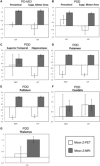Grey matter hypometabolism and atrophy in Parkinson's disease with cognitive impairment: a two-step process
- PMID: 24951642
- PMCID: PMC4610189
- DOI: 10.1093/brain/awu159
Grey matter hypometabolism and atrophy in Parkinson's disease with cognitive impairment: a two-step process
Abstract
The pathophysiological process underlying cognitive decline in Parkinson's disease is not well understood. Cerebral atrophy and hypometabolism have been described in patients with Parkinson's disease and dementia or mild cognitive impairment with respect to control subjects. However, the exact relationships between atrophy and hypometabolism are still unclear. To determine the extension and topographical distribution of hypometabolism and atrophy in the different cognitive states of Parkinson's disease, we examined 46 patients with Parkinson's disease (19 female, 27 male; 71.7 ± 5.9 years old; 14.6 ± 4.2 years of disease evolution; modified Hoehn and Yahr mean stage 3.1 ± 0.7). Cognitive status was diagnosed as normal in 14 patients, as mild cognitive impairment in 17 and as dementia in 15 patients. Nineteen normal subjects (eight female, 11 male; 68.1 ± 3.2 years old) were included as controls. (18)F-fluorodeoxyglucose positron emission tomography and magnetic resonance imaging scans were obtained, co-registered, corrected for partial volume effect and spatially normalized to the Montreal Neurological Institute space in each subject. Smoothing was applied to the positron emission tomography and magnetic resonance imaging scans to equalize their effective smoothness and resolution (10 mm and 12 mm full-width at half-maximum and Gaussian kernel, respectively). Z-score maps for atrophy and for hypometabolism were obtained by comparing individual images to the data set of control subjects. For each group of patients, a paired Student's t-test was performed to statistically compare the two Z-map modalities (P < 0.05 false discovery rate corrected) using the direct voxel-based comparison technique. In patients with mild cognitive impairment, hypometabolism exceeded atrophy in the angular gyrus, occipital, orbital and anterior frontal lobes. In patients with dementia, the hypometabolic areas observed in the group with mild cognitive impairment were replaced by areas of atrophy, which were surrounded by extensive zones of hypometabolism. Areas where atrophy was more extended than hypometabolism were found in the precentral and supplementary motor areas in both patients with mild cognitive impairment and with dementia, and in the hippocampus and temporal lobe in patients with dementia. These findings suggest that there is a gradient of severity in cortical changes associated with the development of cognitive impairment in Parkinson's disease in which hypometabolism and atrophy represent consecutive stages of the same process in most of the cortical regions affected.
Keywords: FDG-PET; MRI; Parkinson’s disease; dementia; mild cognitive impairment.
© The Author (2014). Published by Oxford University Press on behalf of the Guarantors of Brain. All rights reserved. For Permissions, please email: journals.permissions@oup.com.
Figures





References
-
- Aarsland D, Perry R, Brown A, Larsen JP, Ballard C. Neuropathology of dementia in Parkinson's disease: a prospective, community-based study. Ann Neurol. 2005a;58:773–6. - PubMed
-
- Aarsland D, Zaccai J, Brayne C. A systematic review of prevalence studies of dementia in Parkinson's disease. Mov Disord. 2005b;20:1255–63. - PubMed
-
- Apaydin H, Ahlskog JE, Parisi JE, Boeve BF, Dickson DW. Parkinson disease neuropathology: later-developing dementia and loss of the levodopa response. Arch Neurol. 2002;59:102–12. - PubMed
-
- Ashburner J. A fast diffeomorphic image registration algorithm. Neuroimage. 2007;38:95–113. - PubMed
Publication types
MeSH terms
Substances
LinkOut - more resources
Full Text Sources
Other Literature Sources
Medical

